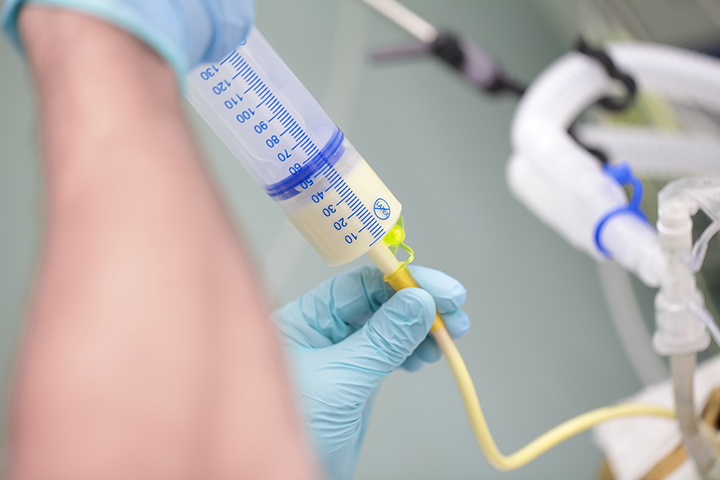What would you do in this situation?
Takeaways:
- Acute aspiration of tube feeding can result in a respiratory emergency
- Know the signs and symptoms of tube feeding aspiration: increased blood pressure, heart rate, and respiratory rate; decreased oxygen saturation; and new onset audible rhonchi and wheezes.
RACHEL JECKER*, age 28, was admitted to the intensive care unit (ICU) 3 days ago after a moderate traumatic brain injury. She’s being transferred to the medical unit under the care of neurosurgery. Her level of consciousness is improving but she has periods of confusion and lethargy. Ms. Jecker’s mother says that a family member is almost always at Ms. Jecker’s bedside during daylight hours.
Enteral feeding: Indications, complications, and nursing care
Verifying NG feeding tube placement in pediatric patients
Fine-tuning your feeding-tube insertion skills
To protect Ms. Jecker’s airway and provide adequate nutrition, a small-bore feeding tube was inserted through her right nares. She’s receiving tube feeding at 60 mL/ hour via a pump. Her vital signs are blood pressure (BP) 120/72 mm Hg, heart rate (HR) 90 beats/minute (bpm), respiratory rate (RR) 28 breaths/minute, and oxygen saturation 96% on room air.
History and assessment hints
Two hours after admission, you enter Ms. Jecker’s room and find her alone, with her feeding tube lying on her chest. She’s restless, coughing, and struggling to catch her breath. Concerned that she’s aspirated the tube feeding, you activate the rapid response team (RRT) and ask the charge nurse to notify the neurosurgery team.
On the scene
While waiting for the RRT, you place Ms. Jecker on a facemask at 10 liters per minute of oxygen. Her vital signs are BP 145/92 mmHg, HR 117 bpm, RR 38 breaths/ minute, and oxygen saturation 88%. The RRT arrives, and you assist them in positioning the patient’s bed at 90 degrees. Kim, the RRT nurse, auscultates Ms. Jecker’s lung fields and says that she hears wheezes and rhonchi throughout. The neurosurgery team arrives and orders a stat chest X-ray and arterial blood gases. Ms. Jecker is transferred to the ICU.
Outcome
In the ICU, Ms. Jecker undergoes a bronchoscopy to visualize and suction her lungs to obtain a specimen for culture and sensitivity for any organisms. The provider orders I.V. ceftriaxone; Ms. Jecker remains confused and lethargic. To avoid the dangers of dislodging another feeding tube, a percutaneous endoscopic gastrostomy is placed, and tube feedings are resumed. After 4 days of antibiotics, Ms. Jecker has stable vital signs; she remains confused but calm, and she’s transferred to the rehabilitation unit.
Education and follow-up
As many as 40% of patients receiving enteral tube feedings aspirate the feedings into their lower respiratory tract, resulting in pneumonia. Dislodged or misplaced enteral feeding tubes, high gastric residual volume (GRV), dysphagia, and poor oral hygiene are all possible causes of aspiration pneumonia. Enteral nutrition practice recommendations include maintaining head-of-bed elevation at 30 to 45 degrees, using chest X-rays to verify initial oral and nasal tube placement, and assessing placement and tolerance of tube feeding every 4 hours by checking GRV amount and gastric pH. A GRV > 250 mL should trigger consideration of a prokinetic agent; a GRV > 500 mL should result in holding tube feeding and assessing glycemic control, sedation use, and prokinetic medications.
In addition, perform oral care with a chlorhexidine solution and teach patients and families about the importance of protecting confused patients from the dangers of accidental tube dislodgment and keeping the head of the bed elevated at least 30 degrees.
*Names are fictitious.
| Editor’s note: For more about preventing NG tube misplacement, visit myamericannurse.com/reducing-nasogastric-tube-misplacement. |
Laura Mcilvoy is a professor in the school of nursing at Indiana University Southeast in New Albany.
Selected references
AACN Practice Alert: Initial and ongoing verification of feeding tube placement in adults (applies to blind insertions and placements with an electromagnetic device). Crit Care Nurse. 2016;36(2):e8-14.
Emergency Nurses Association Clinical Practice Guideline: Gastric tube placement verification. 2018. ena.org/docs/default-source/resource-library/practice-resources/cpg/gastrictubecpg7b5530b71c1e49e8b155b6cca1870adc.pdf?sfvrsn=a8e9dd7a_12
Maeda K, Akagi J. Oral care may reduce pneumonia in the tube-fed elderly: A preliminary study. Dysphagia. 2014;29(5):616-21.
McClave SA, Taylor BE, Martindale RG, et al. Guidelines for the provision and assessment of nutrition support therapy in the adult critically ill patient: Society of Critical Care Medicine and American Society for Parenteral and Enteral Nutrition. JPEN J Parenter Enteral Nutr. 2016;40(2):159-211.



















1 Comment.
I worked in ICU and my experiences with nurses with repositioning vented and tube feeding patients are having the head of the bed lowered like reverse Trendelenburg as it is easy to pull patients up to sit up in bed, especially when only 2 nurses are available. Although, in my opinion, I do not let this practice happen as I believe a patient may aspirate.